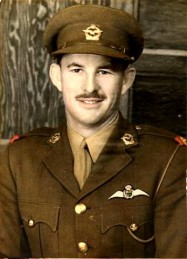The ever-increasing Mosquito strength was put to good effect on 1/2 February, 1945 when 176 Mosquito sorties were flown on eight separate targets. Ludwigshafen, Mainz, Siegen, Bruckhausen, Hannover, Nuremburg and Berlin were all hit; the latter involving 122 Mosquitoes. Berlin would suffer mercilessly at the hands of the LNSF during the final months of the war and, from 20/21 February, the capital was attacked on 36 consecutive nights. Averaging 60 Mosquitoes per raid, 2,538 sorties were flown to Berlin, of which 2,409 were successful. Some 855 cookies were dropped on the city during this period alone and the LNSF continued to bomb Berlin right up to the arrival of the Russian forces in late April 1945.
Pforzheim was almost wiped off the map on 23/24 February when it was bombed by 367 Lancasters and thirteen Mosquitoes from 1, 6 and 8 Groups for the first and last time. The raid was led by MB, Capt E. Swales DFC, SAAF (the only member of the SAAF to serve with the PFF), and a new method was used in an attempt to draw away enemy night-fighters from the main force. The attack was a Controlled Musical Parramatta at low level and a Mandrel screen was used to cover a Window spoof. The Main Force approached the target at just 5,000 ft until it reached 07°00E (over Saarbrücken) and then climbed to 8,000 ft, on track for Pforzheim. Despite the spoofing and different approach to the target, a large formation of enemy night-fighters was already congregating over Stuttgart and they would make their presence felt.
The MB, his deputy and two PVMs easily identified the A/P with the help of Blind Illuminators’ flares which were dropped accurately around TIs positioned by Oboe. The PFF then quickly dropped an excellent concentration of reds and greens. The Main Force then followed up with an excellent piece of bombing which saw 1,825 tons of bombs fall within 22 minutes, devastating over 80% of the town. It is believed that 17,600 people were killed, the majority in a firestorm which erased an area of the town measuring 3 km by 1½ km. The death toll was only surpassed by Hamburg and Dresden during the entire war.
For the attackers, ten Lancasters were shot down and two more crashed in France; one of the latter was from 8 Group. The PFF only lost one bomber this night, namely that of the MB, Capt Swales, in Lancaster III PB538 of 582 Squadron. Just eight minutes after dropping his TIs and while still controlling the raid, Swales’ Lancaster was attacked by an Me410 flown by Hptm G. Friedrich of II./NJG1. The fighter was spotted first by the rear gunner, Plt Off N. Bourne RCAF who lost sight of it before spotting it again climbing towards PB538 to attack. Bourne called for Swales to dive to starboard, but the message never got through and the Me410 opened fire at 800 yards while the rear gunner returned fire. Bourne saw his tracer hit the night-fighter but Friedrich continued his attack, raking the Lancaster with long bursts of fire. By now, the mid-upper gunner, Flt Sgt B. Leach also picked up the fighter at 400 yards but could not get a bead on it until it broke away to port. Leach also scored hits on the Me410 as the fighter rolled off the top of its turn and dived away vertically.
The attack had taken its toll on the Lancaster, with the tailplane and rudder damaged and the port inner engine in flames, although the fire came under control when the engine was feathered. The starboard inner also had to feathered and the starboard fuel was holed. Swales ordered his crew to don their parachutes but rescinded the order when he realised that PB538 continued to perform as normal and even dared to climb. The main concern was how long the electrics would last because the generator was driven off the inner engines and, without current, the crucial DR compass would fail. Approaching a cold front, the loss of blind-flying instruments put the aircraft in perilous danger and, once again, the captain ordered his crew to don parachutes and bail out. Once the last one was safely away from the Lancaster, Swales attempted to make a crash landing but, as he approached the ground, PB538 struck some H/T cables and spun into the ground at La Chappelle-aux-Bois, south of Valenciennes. For his actions that day, Capt E. Swales was awarded Bomber Command’s last and 8 Group’s third VC of the Second World War. Part of his citation, which was gazetted on 24 April 1945 read, ‘Intrepid in attack, courageous in the face of danger, he did his duty to the last, giving his life that his comrades might live.’
